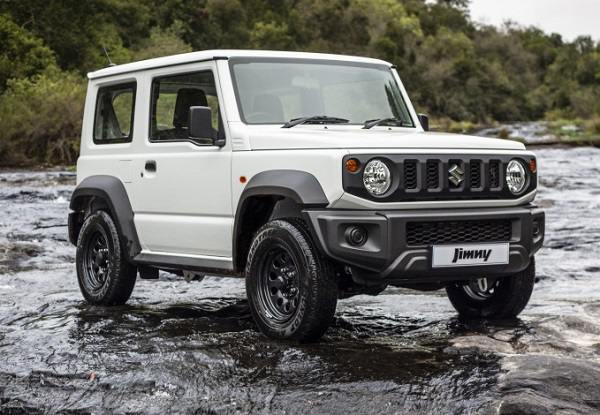
Suzuki’s feisty new Jimny arrives on local shores

At just over 3.6 metres in length, the new Suzuki Jimny that arrived at dealers this week, is some 50mm shorter than its predecessor, and the engine displacement has been increased to 1500 cc.
The new engine is rated at 75 kW at 6000 rpm and 130 Nm at 4000 rpm.
More boxy outside and more roomy inside, while not losing track of its impressive ancestry, motivated the Suzuki engineers who meticulously respecced the entire vehicle.
Divisional Head of Sales and Marketing at Suzuki Auto South Africa, André Venter, said the new Jimny followed the same design brief as all other Suzuki jeeps before it: “Build a compact, lightweight, affordable offroad vehicle with true 4×4 capabilities.”
From the chassis up, every aspect that contributes to the little Suzuki jeep’s incredible 30-year success in southern Africa, came under scrutiny. The new Jimny had to be even better than its predecessors who have all built a solid reputation for genuine offroad capability packaged in a compact city runner.
In the new generation, this is in its most concentrated form, thanks to the Jimny Chief Engineer Hiroyuki Yenezawa’s philosophy of “making the Jimny more attractive by refining every small detail of the model’s design.”
The backbone of the new Jimny is the ladder frame chassis. In the new model, Suzuki’s engineers have added a patented cross member, the Suzuki X-member, between the two rigid axles.
The very rigid ladder frame is the basis of the Suzuki Total Effective Control Technology (TECT) system, which integrates high-strength steel, computer-aided design and the rigid platform for greater crash safety. The X-member consists of two diagonal cross members to limit body flex in serious cross-axle offroad driving.
The second essential element of a true offroader is the rigid axle suspension system which mechanically forces one wheel down if the opposite wheel is raised from the ground. The axle system also prevents the nose from diving under speed, which is a benefit when driving in dunes.
Suzuki has strengthened the axle housings by 30% and has added a steering damper to the front suspension to limit steering wheel kickback and vibration on rough terrain.
The third element is the proprietory ALLGRIP PRO four-wheel drive with low range transfer gear. The all-new Jimny replaces the push-button selection between 2H (rear-wheel drive), 4H (4WD high gear) and 4L (full low range, 4WD) with a shift lever that is directly connected to the transfer gear and can switch between 2H and 4H on the fly at speeds of up to 100 km/h.
The mechanical four-wheel drive system is greatly enhanced by Suzuki’s proprietary Brake Limited Slip Differential and electronic stability control systems. The Brake LSD-system adjusts torque to the wheel with grip if another wheel on the same axle starts spinning. The system has an extra-power mode, which kicks in below 30km/h in low-range mode for the best possible traction.
More applicable for overland enthusiasts are the angled front and rear bumpers that not only keep them out of the way of rocks and shrubs, but also increase the approach and departure angles. The front bumper design also exposes more of the tyre tread on a horizontal plane for greater climbing capability in rocky off-road conditions.
At the rear of the vehicle, Suzuki designers have moved all the lights into the horizontal rear bumper, which has allowed them to create a wider rear door, for increased practicality.
The spare wheel is fitted to the rear door for easy accessibility, while also freeing up space underneath the luggage floor and allowing for an improved departure angle.
Fuel consumption on a combined cycle has been tested at 6.3 litres per 100 km for the manual and 6.8 litres for the automatic model. The previous generation Jimny was rated at 7.2 litres and 7.8 litres per 100 km respectively.
The Jimny offers two specification levels (GA and GLX), and two transmission options (five-speed manual and four-speed automatic)
The GLX model is standard with a 4-year / 60,000 km service plan and the GA model with a 2-year / 30,000 km service plan. All models are sold with a 5-year / 200,000 km mechanical warranty.











































